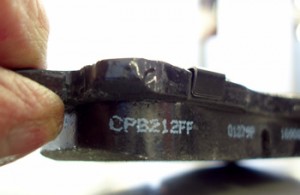 When the friction value changes, which it will most certainly do with different friction material, the stability control and ABS systems will not get to the best correction as quickly as it was capable of when it had all of the parts it was expecting. In most cases, the system will learn and correct for the “error” the new pads have introduced. It just will take more tries to get there and take longer. This results in reduced efficiency by some measurable factor.
When the friction value changes, which it will most certainly do with different friction material, the stability control and ABS systems will not get to the best correction as quickly as it was capable of when it had all of the parts it was expecting. In most cases, the system will learn and correct for the “error” the new pads have introduced. It just will take more tries to get there and take longer. This results in reduced efficiency by some measurable factor.
The systems will still operate and still provide substantial improvements in vehicle handling control and safety vs. not having them. They are highly adaptable, but they just won’t be as perfect as they once were. In most cases, this will be very difficult, if not impossible, to detect at the driver seat.
If you were to measure the true performance of the vehicle by things like stopping distance, amount of steering correction, amount of pedal feedback and more complicated things like yaw gains and maneuver entry speeds, you could expect to find measurable degradation under many maneuvers.
Since the system is generally very good at minimizing these effects, it would be easy to convince the driver/ consumer that this is of no consequence and that they should not consider this as part of their buying decision when it comes to selection of brake replacement.
The ability to “copy” a friction material’s characteristics is a very difficult task under the best of circumstances. All service technicians should consider that the OEMs and developers of these systems have invested thousand of hours by some really smart and dedicated people and spent millions of dollars to tune these systems to their maximum capability and insure they work in absolute harmony with the rest of the vehicle.
While this is done in some pretty obscure and unfriendly environments at times, it is all done to ensure maximum performance and control in the blizzard, torrential downpour or when the dog jumps in front of YOUR car. Any decision to compromise this balance should be given careful consideration. As a general guideline, I would offer the following few thoughts:
- If you chose to not use high-quality replacement pads that mirrors the original friction characteristics, always chose a material with the same friction rating on the edge code. (EE, FF) etc.
- If you chose to change the friction level to a different value (i.e. from EE to FF), change it on all four wheels together. Do this regardless of the level of wear on the other axle, and regardless of whether you are choosing to raise or lower the friction level. This will at least ensure that the braking ratio from front-to-rear is maintained as much as possible.
- Never replace only the Rear Brakes with a pad that has a higher friction level than what is specified for the vehicle. This will increase the amount of rear braking and increase the potential for a rear over brake condition under some road surface and loading conditions.
In the modern vehicle, the wheel brake is challenged to contribute to a great many vehicle driving conditions extending way beyond just stopping the car. The friction material is a very key element in this. To maintain the optimum performance, it is important to understand the implications of the choices that are being offered to consumers and help them make an educated decision.
